Summary
Percentage cover data from vegetation in the Narrator catchment, Dartmoor, have been analysed by reciprocal averaging ordination and by Ward's error sum of squares classification technique. Eleven plant community types have been identified which are compared with the classification of Dartmoor vegetation by Ward et al. (1972). Ordination shows that two groups of environmental variables are important in determining the composition and distribution of the vegetation. The first axis correlates with soil moisture, pH, soil/peat depth and slope angle, while the second axis is explained by biotic factors, particularly burning and grazing. The significance of drainage basins as basic units for the study of vegetation in areas where soil moisture is an important factor is discussed.
Similar content being viewed by others
References
Brunsden, D. & J., Gerrard. 1970. The physical environment of Dartmoor. In: C., Gill (ed.), Dartmoor: a new study. pp. 21–54, David & Charles, Newton abbot.
Clapham, A.R., T.G., Tutin & E.F., Warburg. 1962. Flora of the British Isles. 2nd Ed., Cambridge University Press, London.
Clayden, B. & D.J.R., Manley 1964. The soils of the Dartmoor granite. In: I.G., Simmons (ed.), Dartmoor Essays. pp. 117–140, Devon Assoc. Adv. Sci. Literature & Art, Torquay.
Coombe, D.E. & L.C., Frost. 1956. The heaths of the Cornish serpentine. J. Ecol. 44: 226–256.
Dearing, J. 1977. Gorse, man and landuse change on Dartmoor: a preliminary investigation. Rep. Trans. Devon Ass. Advnt. Sci. 109: 135–152.
Duffey, E., M.G., Morris, G., Sheall, L.K., Ward, D.A., Welis & T.C.E., Wells. 1974. Grassland ecology and wildlife management. Chapman and Hall, London.
Fogwill, E. 1952. The past agricultural utilisation of Dartmoor. M.A. Thesis, University of London, 150 pp.
Frenkel, R.E. & C.M., Harrison. 1974. An assessment of the usefulness of phytosociological and numerical classificatory methods for the community biogeographer. J. Biogeogra. 1: 27–56.
Gauch, H.G., R.H., Whittaker & T.R., Wentworth. 1977. A comparative study of reciprocal averaging and other ordination techniques. J. Ecol. 65: 157–174.
Gimingham, C.H. 1960. Biological Flora of the British Isles. Calluna vulgaris (L.). Hull. J. Ecol. 48: 455–583.
Grubb, P. & M.B. Suter. 1971. The mechanism of acidification of soil by Calluna and Ulex and the significance for conservation. In: E. Duffey & A.S. Watt (eds.) The Scientific management of animal and plant communities for conservation. pp. 115–133, 11th. Symp. Brit. Ecol. Soc.
Harris, G.T. 1938. An ecological reconnaissance of Dartmoor. Rep. Trans. Devon. Ass. Advnt. Sci. 70: 37–55.
Harvey, L.A. & D. St., Leger-Gordon. 1974. Dartmoor. Revised ed. Fontana New Naturalist, Collins.
Havinden, M. & F., Wilkinson 1970. Farming. In: C., Gill (ed.), Dartmoor: A new Study. pp. 139–181, David & Charles, Newton Abbot.
Hill, M.O. 1973. Reciprocal averaging: an eigenvector method of ordination. J. Ecol. 61: 237–249.
Ivimey-Cook, R.B. 1959. Biological Flora of the British Isles. Agrostis setacea Curt. J. Ecol. 47: 697–706.
Ivimey-Cook, R.B., M.C.F., Proctor & D.M., Rowland. 1975. Analysis of the plant communities of a heathland site: Aylesbeare Common, Devon, England. Vegetatio 31: 33–45.
Johns, E. 1957. The surveying and mapping of vegetation on some Dartmoor pastures. Geographical Studies 4: 129–137.
Kent, M. 1977. BRAYCURT and RECIPRO: two programs for ordination in ecology and biogeography. Computer Applications 4: New Series, Dep. of Geography, University of Nottingham, pp. 589–648.
Nature Conservancy 1969. Report on Dartmoor Ecological Survey. Montane grassland habitat team. Internal Nature Conservancy Report.
Orlóci, L. 1978. Multivariate Analysis in Vegetation Research. 2nd. ed. Junk, The Hague. 451 pp.
Perkins, D.F. 1978. The distribution and transfer of energy and nutrients in the Agrostis-Festuca grassland ecosystem. In: O.W., Heal & D.F., Perkins (eds), Production Ecology of British Moors and Montane Grassland. pp. 375–395. Springer-Verlag, Berlin.
Pritchard, N.M. & A.J.B., Anderson. 1971. Observation on the use of cluster analysis in botany with an ecological example. J. Ecol. 59: 727–747.
Proctor, M.C.F. 1969. Flora and vegetation. In: F. Barlow (ed.) Exeter and its Region. pp. 97–116, Brit. Assoc., University of Exeter.
Simmons, I.G. 1963. The blanket bog of Dartmoor. Rep. Trans. Devon. Ass. Advant. Sci. 95: 180–196.
Simmons, I.G. 1964. An ecological history of Dartmoor. IN: I.G., Simmons (ed.), Dartmoor Essays, pp. 191–215, Devon Assoc. Adv. Sci. Literature & Art, Torquay.
Simmons, I.G. 1965. The Dartmoor oak copses: observations and speculations. Field Studies. 2: 225–235.
Ternan, J.L. & A., Williams. 1979. Hydrological pathways and granite weathering on Dartmoor. In: A.F., Pitty (ed.), Geographical approaches to fluvial processes, pp. 5–30. Geoabstracts Ltd., Norwich.
Tubbs, C.R. 1968. The new forest: an ecological history. David & Charles, Newton Abbot.
Vancouver, C. 1808. General View of the agriculture of the County of Devon with Observations on the Means of its Improvement. (Drawn up for the consideration of the Board of Agric. and Internal Improvement) London, David & Charles reprint 1969, Newton Abbot.
Warburg, E.F. 1963. Census Catalogue of British Mosses. 3rd Ed. British Bryological Society.
Ward, S.D., A.D., Jones & M., Manton. 1972 The vegetation of Dartmoor. Field Studies. 3: 505–533.
Ward, J.H. 1963. Hierarchical grouping to optimize an objective function. J. Amer. Statist. Ass. 58: 236–244.
Watt, A.S. 1955. Bracken versus heather, a study in plant sociology. J. Ecol. 43. 490–506.
Wishart, D. 1970. Clustan IA User Manual. Ed. 1, 118 pp. Computing Laboratory, University of St. Andrews, St. Andrews, Fife. (Computer print-out).
Worth, R.H. 1933. Dartmoor. Reprinted by David & Charles, Newton Abbot 1970.
Author information
Authors and Affiliations
Additional information
Nomenciature follows Clapham, Tutin & Warburg (1962), and Warburg (1963) for mosses.
We wish to thank Mr. Simon Ward for assistance with field-work, Dr. Stephen Ward, Dr. J.L. Ternan, Mr. P. Sims, Dr. D.L. Wigston and Dr. O.L. Gilbert for constructive comment on early drafts of the manuscript and Miss S Webber for cartographic work.
Rights and permissions
About this article
Cite this article
Kent, M., Wathern, P. The vegetation of a Dartmoor catchment. Vegetatio 43, 163–172 (1980). https://doi.org/10.1007/BF00158746
Accepted:
Issue Date:
DOI: https://doi.org/10.1007/BF00158746




